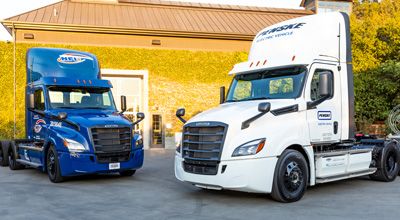
Freightliner: How Electric Trucks Will Change Your Garage Operations
Numerous signs point toward an all-electric future in transportation.
But as more plug-in electric trucks become commercially available for fleets, how will the new technology impact your garage operations? What will change with technician training, equipment and other aspects of your shop?
Daimler Trucks North America plans to start production of its plug-in electric Freightliner eCascadia and eM2 models in 2022. So, UFP spoke with Gregory Bowen, the electric mobility developer and trainer at DTNA, and Jason Ascher, DTNA’s e-mobility engineer, to get their perspective on what you can expect as you prepare your shop to work on EVs in the coming years.
Here’s an edited excerpt of our conversation.
UFP: How will technician training change with battery-electric trucks?
Gregory Bowen: Our technician training philosophy [at DTNA] is that we like to take an A-plus-B approach. We don’t say, “Hey, this is an electric truck, and it’s completely different than anything you’ve ever seen before.” Instead, we start with, “This is an eCascadia, and it’s a Cascadia at heart. You’ve all seen this truck. You’re familiar with it. You know where these components are. Now, let’s talk about what’s different.” This approach makes it a lot easier from a culture shock perspective for a technician to begin by understanding the parallels between the conventional truck and the electric. And then talk about the differences.
As far as skills, we have three types of training we’re going to offer for electric trucks: safety training, technical training on how to work on the vehicle and battery-specific training.
When you say safety training, what does that encompass?
Bowen: The EV safety training program was adopted from the DGUV 8686 E guidelines, which lay out all the training that’s required to work on high-voltage vehicles. Major automotive manufacturers have signed off on these guidelines and teach to that standard. So, we’ve adopted that training program and made sure that it ticks all the OSHA boxes here in the U.S. as well.
There are three training levels depending on a technician’s job description and responsibilities. The high-voltage 3 level is a three-day in-person class. And the two levels below – HV 1 and HV 2 – are web-based courses.
If I understand you correctly, the safety training centers around technicians working with high-voltage electricity?
Bowen: Yes. It’s super easy to turn off the electricity on a truck. You simply turn the key to the off position. And if everything is working the way it’s supposed to, all the high voltage should be turned off. But the nuance we teach is, “Here’s how you make absolutely sure that it’s turned off.” We don’t just take it for granted that, “Oh yeah, well, we turn the key off, and it’s probably safe.” So, the focus of the HV 3 classes is this: How does a technician make absolutely sure, beyond any shadow of a doubt, that this truck is safe to work on.
When technicians work on electric vehicles, do they need a different type of personal protective equipment than when they’re working on conventional vehicles?
Jason Ascher: Yes, whenever the status of the high-voltage system is unknown. If you’re in the middle of turning the truck off and haven’t 100% verified that it’s turned off, you still must wear electrical PPE. There is also arc flash PPE that prevents you from getting injured if there is an arc flash event, and that’s a separate thing. We’re still running calculations to determine whether that’s required for our level of battery.
What does the technical training cover?
Bowen: Technical training is going to be a little bit different than what we’ve delivered in the past for diesel mechanics, where the focus has been on troubleshooting, troubleshooting, troubleshooting.
The difference with working on EVs is that techs aren’t allowed to do seat-of-the-pants troubleshooting. Instead, whenever a high-voltage technician services one of these trucks, they must work step by step through a safety-approved procedure.
So, that will most likely be the most significant difference in how fleets do maintenance on these trucks. There won’t be the free-form troubleshooting that techs have been used to and encouraged to do with conventionally powered vehicles.
What does the battery training entail?
Bowen: It provides more safety training specifically for battery hazards. That’s because, in addition to high voltage, you have to account for unlikely events like fires, electrolyte leakage and other potential issues that theoretically could happen. And there are OSHA requirements since batteries are classified as Class 9 hazardous materials. So, our basic battery class will cover the OSHA requirements for safely handling batteries.
Beyond that, the next step up for the battery specialist will be the ability to determine if the battery – after a crash – is safe and able to be used in a vehicle.
What should utility fleet professionals be thinking about now as they prep their shops to be able to work on electric trucks?
Ascher: The ideal environment would be a dedicated bay for electric vehicles, separate from the rest of the shop. Even if they don’t do high-voltage repairs there in-house, they could have barricades to signify that these are electric trucks. This is a general safety approach that we teach. And then have dedicated technicians trained to safely work on those vehicles.


